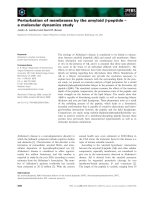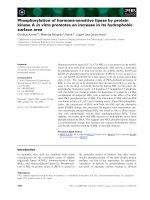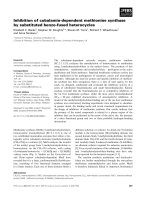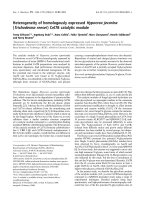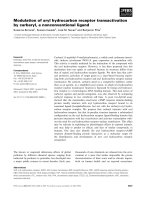Báo cáo khoa học: "Outcomes of interfacility critical care adult patient transport: a systematic review" pptx
Bạn đang xem bản rút gọn của tài liệu. Xem và tải ngay bản đầy đủ của tài liệu tại đây (134.8 KB, 7 trang )
Open Access
Available online />Page 1 of 7
(page number not for citation purposes)
Vol 10 No 1
Research
Outcomes of interfacility critical care adult patient transport: a
systematic review
Eddy Fan
1
, Russell D MacDonald
2,3
, Neill KJ Adhikari
4
, Damon C Scales
4
, Randy S Wax
5
,
Thomas E Stewart
6
and Niall D Ferguson
7
1
Fellow, Interdepartmental Division of Critical Care Medicine, University of Toronto, 399 Bathurst Street, F2-150, Toronto, Ontario, M5T 2S8, Canada
2
Assistant Professor, Division of Emergency Medicine, Department of Medicine, Sunnybrook and Women's College Health Sciences Centre,
University of Toronto, 2075 Bayview Avenue, Toronto, Ontario, M4N 3M5, Canada
3
Medical Director, Research Program, Ontario Air Ambulance, 20 Carlson Court, Suite 400, Toronto, Ontario, M9W 7K6, Canada
4
Instructor, Interdepartmental Division of Critical Care Medicine, and Department of Medicine, Division of Respirology, Sunnybrook and Women's
College Health Sciences Centre, University of Toronto, 2075 Bayview Avenue, Rm B7-08, Toronto, Ontario, M4N 3M5, Canada
5
Assistant Professor, Interdepartmental Division of Critical Care Medicine, and Department of Medicine, Division of Respirology, Mount Sinai Hospital,
University of Toronto, 600 University Avenue, Suite 1818, Toronto, Ontario, M5G 1X5, Canada
6
Associate Professor, Interdepartmental Division of Critical Care Medicine, and Department of Medicine, Division of Respirology, Mount Sinai Hospital
and University Health Network, University of Toronto, 600 University Avenue, Suite 1818, Toronto, Ontario, M5G 1X5, Canada
7
Assistant Professor, Interdepartmental Division of Critical Care Medicine, and Department of Medicine, Division of Respirology, University Health
Network, University of Toronto, 399 Bathurst Street, Toronto, Ontario, M5T 2S8, Canada
Corresponding author: Niall D Ferguson,
Received: 22 Aug 2005 Revisions requested: 2 Oct 2005 Revisions received: 24 Oct 2005 Accepted: 31 Oct 2005 Published: 1 Dec 2005
Critical Care 2006, 10:R6 (doi:10.1186/cc3924)
This article is online at: />© 2005 Fan et al.; licensee BioMed Central Ltd.
This is an open access article distributed under the terms of the Creative Commons Attribution License ( />),
which permits unrestricted use, distribution, and reproduction in any medium, provided the original work is properly cited.
Abstract
Introduction We aimed to determine the adverse events and
important prognostic factors associated with interfacility
transport of intubated and mechanically ventilated adult
patients.
Methods We performed a systematic review of MEDLINE,
CENTRAL, EMBASE, CINAHL, HEALTHSTAR, and Web of
Science (from inception until 10 January 2005) for all clinical
studies describing the incidence and predictors of adverse
events in intubated and mechanically ventilated adult patients
undergoing interfacility transport. The bibliographies of selected
articles were also examined.
Results Five studies (245 patients) met the inclusion criteria. All
were case-series and two were prospective in design. Due to
the paucity of studies and significant heterogeneity in study
population, outcome events, and results, we synthesized data in
a qualitative manner. Pre-transport severity of illness was
reported in only one study. The most common indication for
transport was a need for investigations and/or specialist care
(three studies, 220 patients). Transport modalities included air
(fixed or rotor wing; 66% of patients) and ground (31%)
ambulance, and commercial aircraft (3%). Transport teams
included a physician in three studies (220 patients). Death
during transfer was rare (n = 1). No other adverse events or
significant therapeutic interventions during transport were
reported. One study reported a 19% (28/145) incidence of
respiratory alkalosis on arrival and another study documented a
30% overall intensive care unit mortality, while no adverse
events or outcomes were reported after arrival in the three other
studies.
Conclusion Insufficient data exist to draw firm conclusions
regarding the mortality, morbidity, or risk factors associated with
the interfacility transport of intubated and mechanically
ventilated adult patients. Further study is required to define the
risks and benefits of interfacility transfer in this patient
population. Such information is important for the planning and
allocation of resources related to transporting critically ill adults.
Introduction
Regionalization of care and the requirement for specialized
resources result in the frequent need for interfacility transport
of critically ill patients [1-3]. Although some of these patients
may derive significant benefit from such a transfer, they may
also be at considerable risk of transport-related morbidity and
mortality [4-12]. The decision to initiate the interfacility trans-
port of a critically ill patient must, therefore, be taken carefully.
Critical Care Vol 10 No 1 Fan et al.
Page 2 of 7
(page number not for citation purposes)
The impact of specific pre-transport and transport-related fac-
tors on morbidity and mortality are not well established, how-
ever, limiting the ability of clinicians to target particular patients
where additional resources and care during transportation
might be beneficial. For example, if high-risk patients could be
reliably identified, they could undergo additional pre-transport
resuscitation [13,14] and/or be accompanied by specially
trained transport personnel with additional equipment in order
to anticipate and reduce transport-associated risks [15-21].
Several professional societies have developed guidelines for
the inter- and intrafacility transport of critically ill patients [22-
25]; however, these guidelines focus primarily on general prin-
ciples (for example, pre-transport stabilization, minimum trans-
port equipment and medications) and the composition of the
transport team, rather than risk stratification. Understanding
which patients are most at risk while undergoing interfacility
transport and the types of events that occur would be an
important step in patient preparation and aligning resources
(such as equipment and personnel) at the sending and receiv-
ing sites as well as during transportation. To this end, we con-
ducted a systematic review of the literature to determine the
adverse events associated with interfacility transport of
mechanically ventilated adult patients, along with important
pre-transport and transport-related prognostic factors.
Methods
Identification of trials
Our objective was to identify all relevant published clinical
studies describing the incidence and predictors of adverse
events in mechanically ventilated adults undergoing interfacil-
ity transport. We chose to study only intubated and mechani-
cally ventilated patients in order to capture a well-defined
group of critically ill patients with significant severity of illness.
A priori, we defined adverse events related to transportation
as those that occurred during interfacility transport and up to
24 hours after arrival at the destination. A computerized
MEDLINE (1966 to 10 January 2005) search was conducted
using the following medical subject headings: 'transportation
of patients', 'intubation, intratracheal', and 'respiration, artifi-
cial'. In addition, we searched the databases CENTRAL (first
Table 1
Characteristics of included studies
Study n Country Study duration Study design Diagnoses
Barillo et al. (1997) [28] 146 USA Nov 1987 to Sept 1994 Retrospective case series Smoke inhalation
Facial burn/injury
Polytrauma
Pneumonia
Respiratory failure from other causes
Remond et al. (1998) [29] 10 France July 1996 to Sept 1997 Prospective case series Meningitis
Gas gangrene
Post-operative respiratory failure
Carbon monoxide poisoning
Liver transplantation
Stroke
Orf et al. (2000) [30] 15 USA Not reported Prospective case series Traumatic brain injury
Uusaro et al. (2002) [31] 66 Finland 1993 to 1999 Retrospective case series Acute respiratory distress syndrome
Respiratory failure from other causes
Veldman et al. (2004) [32] 8 Germany Not reported Retrospective case series Pneumonia
Guillain-Barre syndrome
Intracranial tumor
Intracranial hemorrhage
Acute respiratory distress syndrome
Anoxic brain injury
Neurodegenerative disease
Available online />Page 3 of 7
(page number not for citation purposes)
quarter 2005), EMBASE (1980 to 10 January 2005), CINAHL
(1982 to 10 January 2005), HEALTHSTAR (1975 to 10 Jan-
uary 2005), and Web of Science (1945 to 10 January 2005)
using the keywords: 'transport', 'ventilation', and 'intubation'.
No language restrictions were applied. Bibliographies of all
selected articles and review articles [26,27] on interfacility
patient transport were examined for other relevant studies.
This strategy was performed iteratively, until no new clinical
trial citations were found on review of the reference lists of
retrieved articles. Full details of the searches are available
upon request.
Study selection and data abstraction/analysis
The following selection criteria were used to identify published
studies for inclusion in our analysis: clinical trial or cohort study
or case-series (study design); all patients intubated and
mechanically ventilated, and aged ≥ 18 years (study popula-
tion); and interfacility transport (for example, from one health
care facility to another health care facility). Interfacility trans-
ports between two sites of the same institution were included
if the means of transportation involved air or ground
ambulance.
Two reviewers (EF and RDM) independently applied the selec-
tion criteria and abstracted the data using standardized forms.
The reviewers abstracted data on description of the cohort,
methods, adverse events/outcomes, and transport-related
interventions. We report descriptive data from individual trials
as mean ± standard deviation, unless otherwise stated.
Because of the paucity of studies and the heterogeneity in
study populations and reported outcomes, we did not conduct
a meta-analysis.
Results
The combined computerized and bibliographic literature
search yielded 599 potentially relevant studies, of which 24
articles were identified for more detailed review (Figure 1).
Only five studies satisfied our inclusion criteria [28-32]. There
was moderate initial agreement between reviewers for study
inclusion (raw agreement = 0.80, chance-corrected agree-
ment κ = 0.65 ± 0.16); all disagreements were resolved by
consensus.
The five included studies (Tables 1 and 2) enrolled 245 criti-
cally ill patients (median 15; range 8 to 146) with a wide vari-
ety of diagnoses. All were case-series, two of which were
prospective. The most common indication for interfacility
transport was the need for investigations and/or specialist
care not available at the referring institution (three studies, 220
patients) [28,29,31,32]. The results of the included studies
are summarized in Table 3.
Pre-transport characteristics
Only 1 study reported severity of illness (Sepsis-related Organ
Failure Assessment (SOFA) [33] score of 10 ± 3) prior to
transport [31]. Another study reported pre-transport arterial
blood gas results from transported burn patients [28]. The
other three studies provided little data on pre-transport status
that would be useful in standardizing comparisons across
patient groups.
Transport characteristics
Modalities used for interfacility transport included air (fixed or
rotor wing; 66% of patients) and ground (31%) ambulance,
and commercial aircraft (3%). Transport teams included a phy-
sician in 3 studies (220 patients) [28,31,32]. In one study, 14
patients (21%) were transported in the prone position
because of life-threatening hypoxemia [31]. Death during
Table 2
Transport characteristics of included studies
Study n Transport
provider
Indication for transport Transport method Transport distance/
time
a
Transport team
Barillo et al.
(1997) [28]
146 Public Need for investigation
and/or specialist
facilities
Air ambulance (fixed
wing > 150 miles;
helicopter < 150
miles)
Helicopter (100 miles);
fixed wing (912
miles)
Burn surgeon, ICU RN,
RT, and medical
technician
Remond et al.
(1998) [29]
10 Not reported Not reported Ground ambulance 117 minutes Not reported
Orf et al. (2000)
[30]
15 Private Not reported Helicopter Not reported RN and paramedic
Uusaro et al.
(2002) [31]
66 Not reported Need for investigation
and/or specialist
facilities
Ground ambulance 161 km (median); 161
minutes (median)
Intensivist, RN, and 2
paramedics
Veldman et al.
(2004) [32]
8 Private Repatriation; need for
investigation and/or
specialist facilities
Commercial airline 1,700-10,280 nautical
miles; 250-1,315
minutes
MD and RN
a
Mean transport distance and time are reported unless otherwise specified. ICU, intensive care unit; MD, medical doctor; RN, registered nurse;
RT, respiratory therapist.
Critical Care Vol 10 No 1 Fan et al.
Page 4 of 7
(page number not for citation purposes)
transport was rare (n = 1) [32]. No other adverse events or sig-
nificant therapeutic interventions during transport were
reported in any of the included studies.
Post-transport characteristics
One study (not the same one that described pre-transport
characteristics) reported severity of illness on arrival and out-
comes following interfacility transport (mean Acute Physiology
and Chronic Health Evaluation (APACHE) II [34] score of 17
± 6; intensive care unit mortality 30%) [29]. The burn study
reported the incidence of respiratory alkalosis on arrival (in
19%) and the survival rate to burn unit discharge (71%) [28].
The presence or absence of post-transport adverse events
was not reported in the other three included studies.
Discussion
The main finding of this systematic review is the paucity of
studies examining adverse events and their associated risk
factors in critically ill patients undergoing interfacility transport.
The few published studies suggest that significant mortality or
morbidity associated with interfacility transport of intubated
adult patients is uncommon; however, there are significant lim-
itations to the available data. First, the estimation of the
incidence of adverse events is unreliable because all studies
were case series (the majority of which were retrospective)
that enrolled few transported patients. Second, associations
between pre-transport variables and adverse outcomes could
not be determined, both because pre-transport status was
poorly documented, and because studies lacked standard
definitions and methods for ascertaining adverse events.
Finally, many studies only examined immediate or short-term
adverse events (for example, during transport or on arrival),
even though it is possible that later adverse events may also
be associated with important transport-related factors (for
example, barotrauma from exposure to high ventilatory pres-
sures during transport may go unrecognized for several
hours).
A number of factors may have contributed to the low morbidity
of interfacility transport documented in this review. These
include the possibility that some patients who were less
severely ill were intubated and ventilated solely to facilitate
safe transportation, thereby lowering the overall acuity of ill-
ness and likelihood of adverse events. The extent to which this
practice occurred was not reported in any of the included
studies. In addition, the composition of the transport teams
may have had an influence. In three of the five included studies,
the transport teams included a physician; in two of these the
physician was a specialist (a burn surgeon and an intensivist).
In addition, a nurse accompanied the patient in all four studies
that reported transport team composition. Interfacility trans-
port is increasingly becoming the jurisdiction of highly trained
and specialized transport personnel [35-38], with at least one
paediatric study demonstrating significantly decreased mor-
bidity associated with the use of such teams [36]. Professional
guidelines have suggested that transport of unstable critically
ill adults should be accompanied by either a physician or a
nurse, preferably with additional training and experience in
transport medicine [22]. The results of our review may not
have been the same if more data were available from trans-
ports without such individuals.
Although transport methods, distance, and time differ in intra-
hospital transfers, the risks and types of adverse events for the
Table 3
Results of included studies
Study n Pre-transport characteristics Transport characteristics or
adverse events
Post-transport characteristics or
adverse events
Barillo et al. (1997) [28] 146 Mean extent of burn injury 40%
TBSA
99% had smoke inhalation injury
No in-flight instability, respiratory
complications, or failure of
ventilation reported
28 pts (19%) with respiratory
alkalosis; 104 (71.2%) survived
to burn unit discharge
Remond et al. (1998) [29] 10 90% sedated
50% with PaO
2
/FiO
2
ratio < 200
No adverse events reported No adverse events reported
Orf et al. (2000) [30] 15 80% manually ventilated Median AVR 24
AVR ≥ 26 in 33.3% of pts
AVR ≥ 30 in 26.7% of pts
Mean AVR was lower in
mechanically ventilated pts (15 ±
3) versus manually ventilated pts
(29 ± 12) (p = 0.01)
Uusaro et al. (2002) [31] 66 52 pts (79%) with ARDS
PaO
2
/FiO
2
ratio 64 ± 20 mmHg
SOFA 10 ± 3
14 pts (21%) transported in prone
position
59 pts (89%) required inotrope/
pressor infusions
Overall ICU mortality 30%
PaO
2
/FiO
2
ratio 73 ± 27 mmHg
APACHE II 17 ± 6
Veldman et al. (2004) [32] 8 All pts ventilator-dependent ≥ 11
days prior to transport
OI ≤ 9.5 prior to transport
Unsuccessful CPR for in-flight
cardiac arrest (n = 1)
Not reported
Data are mean ± standard deviation. APACHE II, Acute Physiology and Chronic Health Evaluation II; ARDS, acute respiratory distress syndrome;
AVR, assisted ventilation rate; CPR, cardiopulmonary resuscitation; ICU, intensive care unit; SOFA, Sepsis-related Organ Failure Assessment;
TBSA, total body surface area; OI, oxygenation index ((FiO
2
× mean airway pressure/PaO
2
) × 100).
Available online />Page 5 of 7
(page number not for citation purposes)
patient may be similar to those undergoing inter-hospital trans-
port [24,39,40]. Several studies of intra-hospital transfers of
critically ill patients have reported transport-related complica-
tions [39-42]. In a recent study [42], 191 incidents related to
intra-hospital transport were identified over a six year period.
The majority of adverse events centered on patient-staff man-
agement issues and equipment problems that culminated in
serious complications in 31% of reported incidents, including
major physiological deterioration in 15% and death in 2% [42].
This relatively high rate of adverse events among reported inci-
dents when intrafacility transport is subjected to close scrutiny
further calls into question the validity of the results of our
review. It seems likely that the potential for adverse events is
significantly higher during air transport between two hospitals
than on a trip to another department within the same hospital
such as the radiology department. Alternatively, a possible
explanation is that patients undergoing intra-hospital trans-
ports are sicker and/or the personnel associated with these
transports are less experienced than inter-hospital transport
teams.
Finally, we acknowledge that a limitation to the generalizability
of our results is the restriction of our review to intubated and
ventilated patients undergoing interfacility transport. In our
attempt to identify and study a well-defined population of
critically ill patients, we may have missed other patients at risk
for adverse events during interfacility transport.
The lack of informative clinical studies evaluating the interfacil-
ity transport of critically ill patients is likely related to a variety
of barriers in conducting research in this setting (Table 4).
Clearly, deciding if patients will undergo interfacility transport
by randomization is infeasible and unethical. Therefore, we
believe that a multi-center, prospective observational cohort
study is the methodology best suited to address the important
questions raised by our review in this rapidly growing field of
transit care medicine. In the design of such a study, attention
would need to be paid to developing and validating consistent
definitions for adverse events. In addition, extensive collabora-
tion between the critical care and transport teams would be
essential.
Conclusion
Few data document the risks of interfacility transport. Until
more robust risk assessment tools become available, common
sense and physiological rationale will continue to guide the
risk/benefit assessment of interfacility transport for individual
patients. We believe that more research is required to docu-
ment the prevalence of adverse events in critically ill patients
during transport, and to elucidate the associated patient- and
transport-related risk factors. Such research could form the
basis of new strategies to optimize patient safety. In addition,
better identification of patients at risk may allow for more effi-
cient and effective alignment of transport-related resources,
such as specialist retrieval teams and enhanced pre-transfer
stabilization.
Competing interests
The authors declare that they have no competing interests.
Authors' contributions
EF, RDM, DCS, TES, and NDF conceived the study. All
authors contributed to the study design and interpretation of
the data. EF and RDM performed the literature search and
abstracted the data. EF wrote the first draft of the manuscript,
which was then revised for intellectually important content by
all authors. All authors read and approved the final manuscript.
Table 4
Barriers to transport research and recommendations for future studies
Barriers/problems Potential solutions/approaches
Lack of validated and feasible definitions for many transport-associated
complications
Develop a priori definitions for transport-associated complications by
expert consensus; validate these prospectively (for example, pilot
study) or retrospectively (for example, chart review)
Difficulties consistently documenting pre-transport clinical status
across multiple sending facilities
Standardization of pre-transport data collection by centralized form/
checklist administered by transport personnel at time of patient
retrieval and/or by telephone follow-up following arrival at receiving
facility
Limited monitoring (for example, no blood tests or X-rays) and
documentation during transport
Standardization of data collection (for example, physiological
parameters) during transport by centralized form/checklist
administered by transport personnel during transport
Under reporting of adverse events/errors due to a real or perceived
culture of blame
Anonymous reporting and independent abstraction of documented
adverse events/errors; achieve 'buy-in' from frontline staff through
education and involvement in project development
Inability to identify an adequately matched, non-transported comparison
group due to heterogeneous patient population transported to tertiary
centers and inevitable selection bias of those chosen for transport to
these centers
Use of a multi-center, prospective observational cohort study including
a broad spectrum of referral institutions; study risk factors for
transport-related adverse events
Critical Care Vol 10 No 1 Fan et al.
Page 6 of 7
(page number not for citation purposes)
References
1. Mackenzie PA, Smith EA, Wallace PGM: Transfer of adults
between intensive care units in the UK. Br Med J 1997,
314:1455-1456.
2. Flabouris A: Patient referral and transportation to a regional
tertiary ICU: patient demographics, severity of illness and out-
come comparison with non-transported patients. Anaesth
Intensive Care 1999, 27:385-390.
3. Grieve CF, Ferguson ND, Adhikari N, Singh JM, Moneta SL,
DeMajo W, Stewart TE, Scales DC: Utilization pattern of
Ontario's critical care referral and transfer facilitation program
[abstract]. Proc Am Thoracic Soc 2005, 2:A597.
4. Olson CM, Jastremski MS, Vilogi JP, Madden CM, Beney KM: Sta-
bilization of patients prior to interhospital transport. Am J
Emerg Med 1987, 5:33-39.
5. Ehrenworth J, Sorbo S, Hackel A: Transport of critically ill adults.
Crit Care Med 1986, 14:543-547.
6. Kanter R, Tompkins J: Adverse events during interhospital
transport: Physiologic deterioration associated with pretrans-
port severity of illness. Pediatrics 1989, 84:43-48.
7. Martin G, Cogbill T, Landercasper J, Strutt PJ: Prospective anal-
ysis of rural interhospital transfer of injured patients to a refer-
ral trauma center. J Trauma 1990, 30:1014-1020.
8. Valenzuela T, Criss E, Copass M, Luna GK, Rice CL: Critical care
air transportation of the severely injured: Does long distance
transport adversely affect survival? Ann Emerg Med 1990,
19:169-172.
9. Kerr HD, Byrd JC: Community hospital transfers to a VA Medi-
cal Center. J Am Med Assoc 1989, 262:70-73.
10. Dragsted L, Jorgensen J, Jensen NH, Bonsing E, Jacobsen E,
Knaus WA, Qvist J: Interhospital comparisons of patient out-
comes from intensive care: Importance of lead-time bias. Crit
Care Med 1989, 17:418-422.
11. Borlase BC, Baxter JK, Kennedy PR, Forse RA, Benotti PN, Black-
burn GL: Elective intrahospital admissions versus acute inter-
hospital transfers to a surgical intensive care unit: Cost and
outcome prediction. J Trauma 1991, 31:915-918.
12. Durairaj L, Will JG, Torner JC, Doebbeling BN: Prognostic factors
for mortality following interhospital transfers to the medical
intensive care unit of a tertiary referral center. Crit Care Med
2003, 31:1981-1986.
13. Henderson A, Coyne T, Wall D, Miller B: A survey on interhospi-
tal transfer of head-injured patients with inadequately treated
life-threatening extracranial injuries. Aust N Z J Surg 1992,
62:759-762.
14. Lambert SM, Willett K: Transfer of multiply-injured patients for
neurosurgical opinion: A study of the adequacy of assessment
and resuscitation. Injury 1993, 24:333-336.
15. Harrahil M, Bartkus E: Preparing the trauma patient for transfer.
J Emerg Nurs 1990, 16:25-28.
16. Gore JM: Feasibility and safety of emergency interhospital
transport of patients during the early hours of acute myocar-
dial infarction. Arch Intern Med 1989, 149:353-355.
17. Anderson C: Preparing patients for aeromedical transport. J
Emerg Nurs 1987, 13:229-231.
18. Greco A: Development of an interfacility transport program for
critically ill cardiovascular patients. Clin Issues Crit Care Nurs
1990, 1:3-12.
19. Fromm RE, Dellinger RP: Transport of critically ill patients. J Int
Care Med 1992, 7:223-233.
20. Runcie CJ, Reeve W, Reidy J, Wallace PG: Secondary transport
of the critically ill adult. Clin Intensive Care 1991, 2:217-225.
21. Selevan JS, Fields WW, Chen W, Petitti DB, Wolde-Tsadik G:
Critical care transport: Outcome evaluation after interfacility
transfer and hospitalization. Ann Emerg Med 1999, 33:33-43.
22. Warren J, Fromm RE, Orr RA, Rotello LC, Horst HM: Guidelines
for the inter- and intrahospital transport of critically ill patients.
Crit Care Med 2004, 32:256-262.
23. Faculty of Intensive Care of the Australian and New Zealand
College of Anaesthetists and Australasian College for Emer-
gency Medicine: Minimum standards for transport of the criti-
cally ill [ />]
24. Faculty of Intensive Care of the Australian and New Zealand
College of Anaesthetists and Australasian College for Emer-
gency Medicine: Minimum standards for intrahospital trans-
port of the critically ill [ />documents/intrahosp_crit_ill.pdf]
25. Intensive Care Society 2002: Guidelines for the transport of
the critically ill adult (UK) [ />icstransport2002mem.pdf]
26. Gray A, Bush S, Whiteley S: Secondary transport of the critically
ill and injured adult. Emerg Med J 2004, 21:281-285.
27. Fromm RE, Varon J: Critical care transport. Crit Care Clin 2000,
16:695-705.
28. Barillo DJ, Dickerson EE, Cioffi WG, Mozingo DW, Pruit BA Jr:
Pressure-controlled ventilation for the long-range aeromedi-
cal transport of patients with burns. J Burn Care Rehabil 1997,
18:200-205.
29. Remond C, Jimeno MT, Dubouloz F: Mesures du CO
2
expire en
transport extrahospitalier: Interets et limites. Jeur 1998,
4:179-186.
30. Orf J, Thomas SH, Wedel SK: Ventilation rates in intubated
head injury patients undergoing helicopter EMS (HEMS)
transport [abstract]. Crit Care Med 2000, 28:A208.
31. Uusaro A, Parviainen I, Takula J, Ruokonen E: Safe long-distance
interhospital ground transfer of critically ill patients with acute
severe unstable respiratory and circulatory failure. Intensive
Care Med 2002, 28:1122-1125.
32. Veldman A, Diefenbach M, Fischer D, Benton A, Bloch R: Long-
distance transport of ventilated patients: advantages and lim-
itations of air medical repatriation on commercial airlines. Air
Med J 2004, 23:24-28.
33. Vincent JL, Moreno R, Takala J, Willatts S, De Mendonca A, Bruin-
ing H, Reinhart CK, Suter PM, Thijs LG: The SOFA (Sepsis-
related Organ Failure Assessment) score to describe organ
dysfunction/failure. Intensive Care Med 1996, 22:707-710.
34. Knaus WA, Zimmerman JE, Wagner DP, Draper EA, Lawrence DE:
APACHE – acute physiology and chronic health evaluation: a
physiologically based classification system. Crit Care Med
1981, 9:591-597.
35. Burtnyk S: Secondary transportation of critically ill people –
implications for nurses and the need for specialist training.
Intensive Crit Care Nurs 1992, 8:234-239.
36. Edge WE, Kanter RK, Weigle CG, Walsh RF: Reduction of mor-
bidity in interhospital transport by specialized pediatric staff.
Crit Care Med 1994, 22:1186-1191.
37. Gebremichael M, Borg U, Habashi NM, Cottingham C, Cunsolo L,
McCunn M, Reynolds HN: Interhospital transport of the
extremely ill patient: the mobile intensive care unit. Crit Care
Med 2000, 28:79-85.
38. Beyer AJD, Land G, Zaritsky A: Nonphysician transport of intu-
bated pediatric patients: a system evaluation. Crit Care Med
1992, 20:961-966.
39. Braman SS, Dunn SM, Amico CA, Millman RP: Complications
during intrahospital transport in critically ill patients. Ann
Intern Med 1987, 107:469-473.
40. Lovell MA, Mudaliar MY, Klineberg PL: Intrahospital transport of
critically ill patients: complications and difficulties. Anaesth
Intensive Care 2001, 29:400-405.
41. Shirley PJ, Stott SA: Clinical and organizational problems in
patients transferred from the intensive care unit to other areas
Key messages
• Few data exist regarding the mortality, morbidity, and/or
risk factors associated with these outcomes in intu-
bated and mechanically ventilated adult patients under-
going interfacility transport.
• Further prospective study is required to define the risks
and benefits of interfacility transfer in this patient
population.
• Such information is important for the planning and allo-
cation of resources related to transporting critically ill
adults.
Available online />Page 7 of 7
(page number not for citation purposes)
within the hospital for diagnostic procedures. Br J Anaesth
2001, 87:346-347.
42. Beckmann U, Gillies DM, Berenholtz SM, Wu AW, Pronovost P:
Incidents relating to the intra-hospital transfer of critically ill
patients. Intensive Care Med 2004, 30:1579-1585.
